American Indian Baskets (Pima)
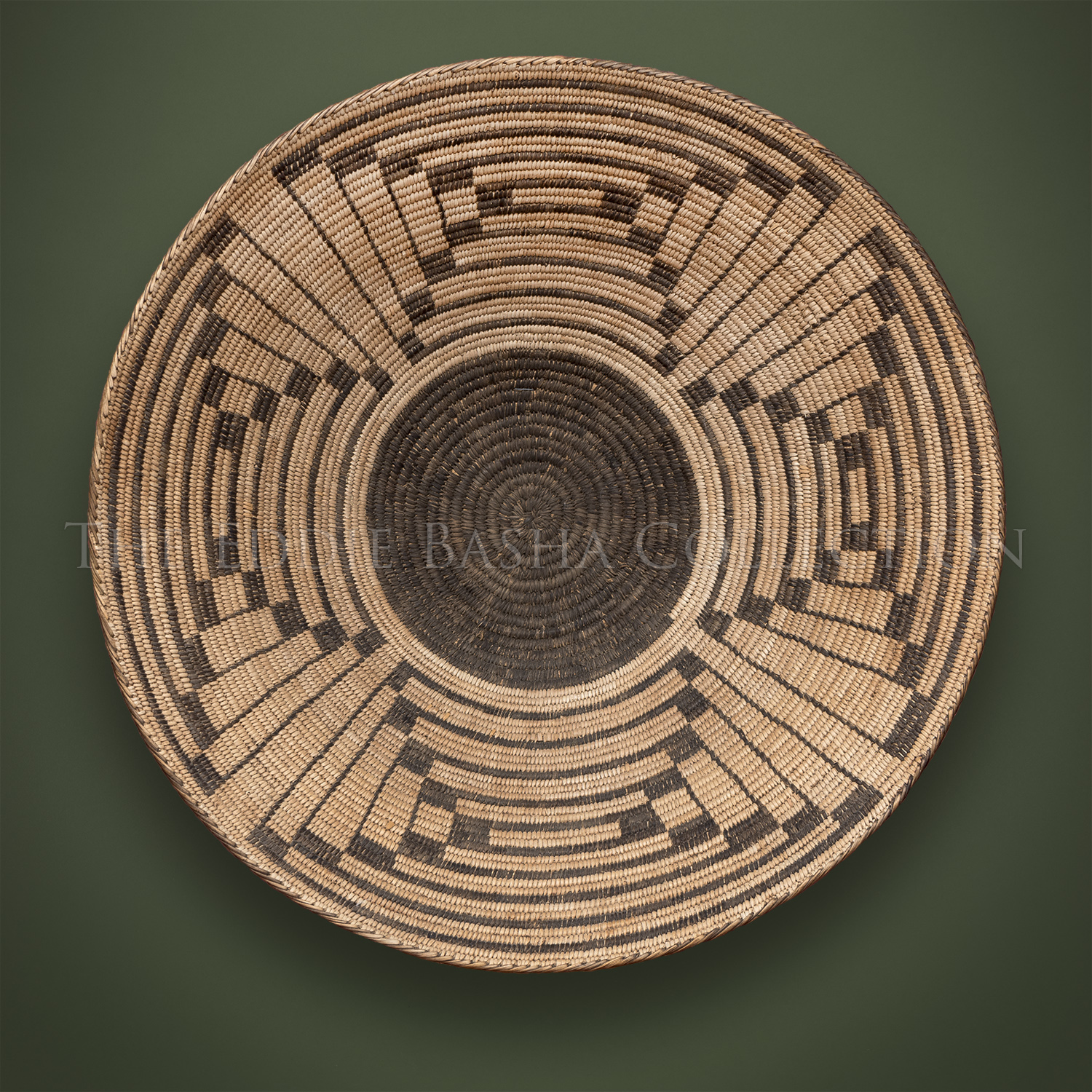
Pima Tray
Artist: Pima
Description: Willow, Devil’s Claw over Three-Rod Foundation (1890) | Dimensions: 20” Diameterbaskets
This large Pima tray depicts a classical four-petal turtleback motif with a large black base. The turtleback design was the foundation of the squash blossom pattern. In this basket one may see a four-petal squash blossom pattern within the square turtleback. It was woven with willow and devil’s claw over a three-rod foundation.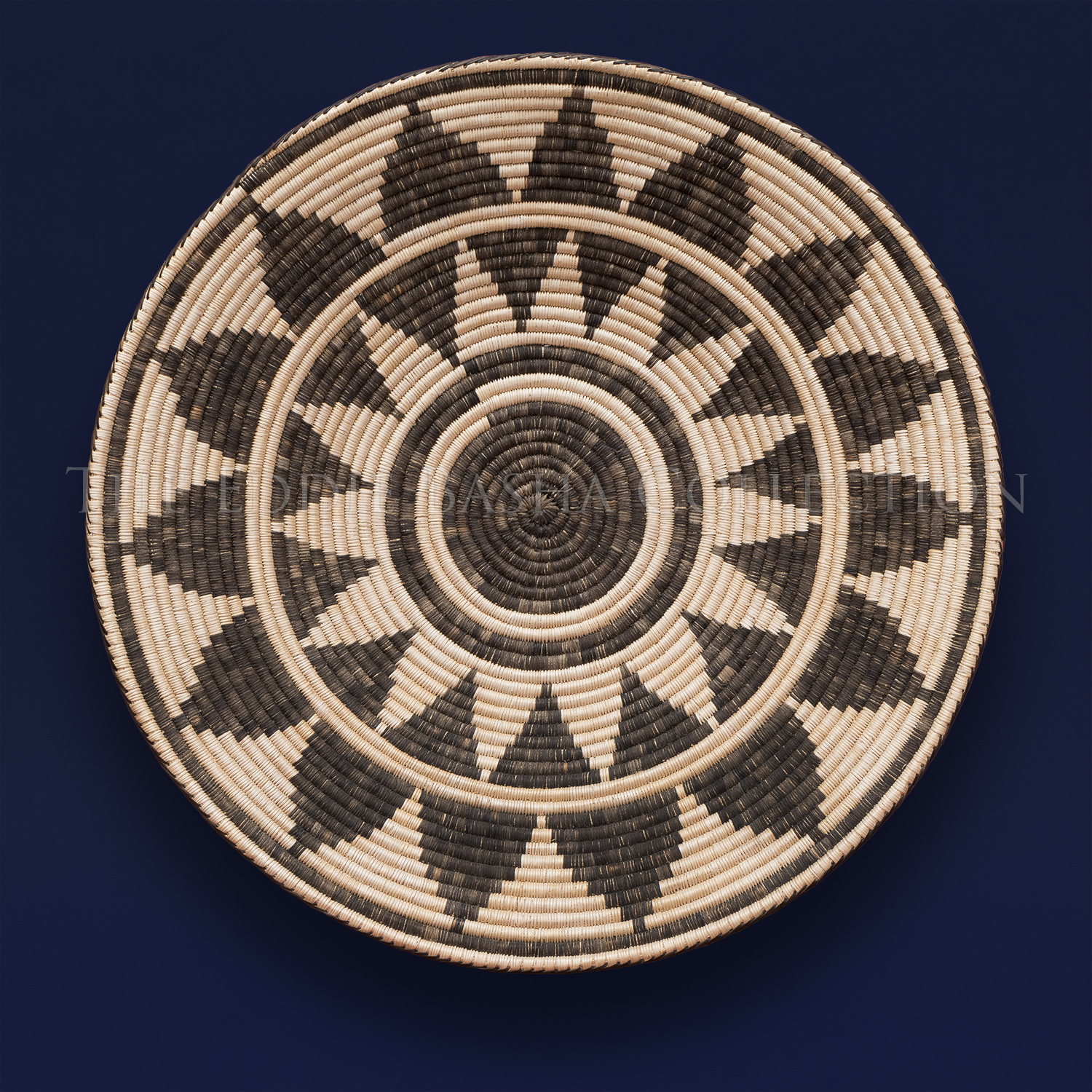
Pima Tray | Unknown Weaver
Artist: Pima
Description: Willow, devil’s claw, over three-rod foundation. (Circa 1950-1970) | Dimensions: 20 ½” Diameterbaskets
An old woven basket pattern described by Breazeale in the book entitled “The Pima and His Basket (1923)” (page 84, figure 74) as the “Pima Sun” design which is a positive/negative radiating sunray motif. This basket motif is also mentioned by Robinson in “The Basket Weavers of Arizona (1954)” as an “old Pima design now seldom used” (page 31, figure plate XVII). This basket is one of the finest examples of a Pima willow basket after World War II and is among one of the last of its kind from the once flourishing abundant array of Pima baskets. It was woven with willow and devil’s claw over a three-rod foundation.
The weaving materials once used are not as readily available as they once were. The Education Department at the Huhugam Heritage Center offers classes and workshops that provide perspectives on aspects of culture, respect and understanding of traditional ecological knowledge system (plants and animals). To revive interest in the basket weaving process and production, the Center implemented one such program wherein participants worked collectively to grow their own materials and study traditional weaving methods of the past. The EBC was honored to host two of these groups that previously visited to study the Pima baskets in the collection.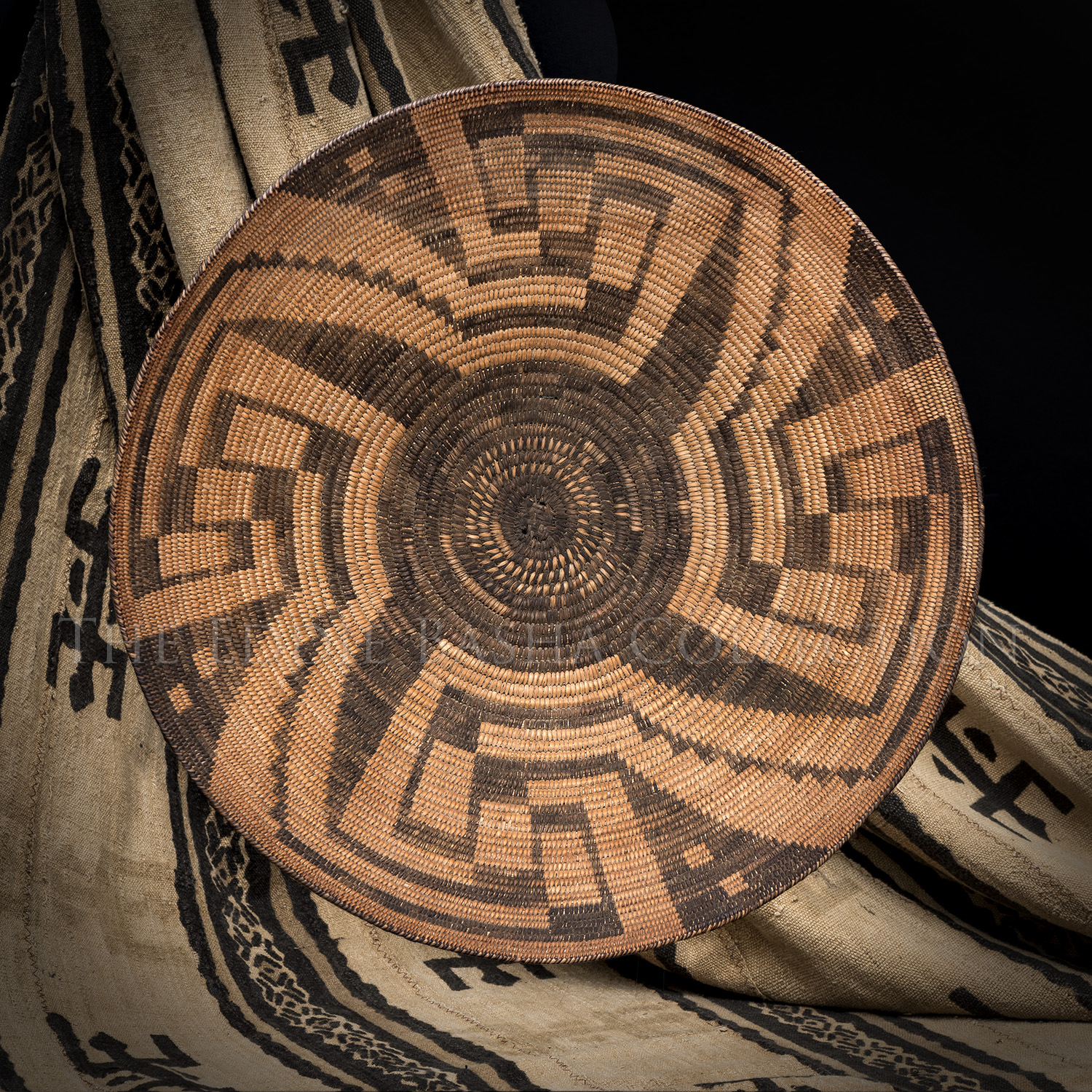
Pima Tray | Unknown Weaver
Artist: Pima
Description: Willow, devil’s claw over cattail (Circa 1900) | Dimensions: 18” Diameterbaskets
This 18” Pima Tray (circa 1900) presents with a balanced fret of whirling logs that have anchor points of diagonally positioned vertical rectangles balanced with negative (dark) triangles containing two small squares in each. It is woven with willow and devil’s claw over cattail.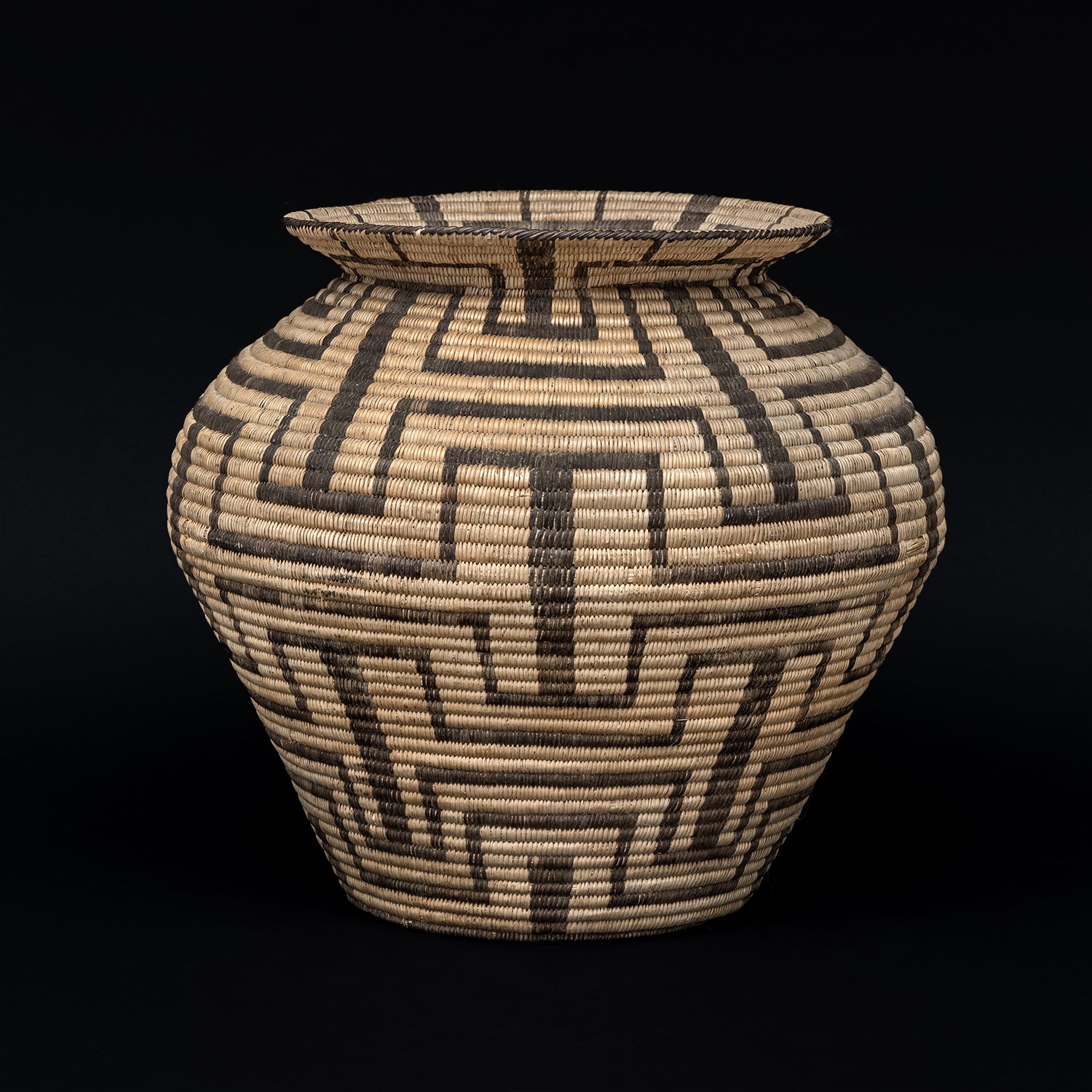
Pima Olla
Artist: Pima
Description: Willow & Devil’s Claw over three-rod foundation (Circa 1920) | Dimensions: 17”h x 14 ½”wbaskets
This Pima Olla woven with willow and devil’s claw over a three-rod foundation, circa 1920, presents a bold, terraced field that highlights wide, dark vertical bars. Its unique, elegant flaring mouth is exceptional.
Pima Tray
Artist: Pima
Description: Willow, devil’s claw and cottonwood (Circa 1910) | Diameter: 19 ¼”baskets
This Pima Tray, 19 ¼” diameter, circa 1910, has four joined serrated arrowhead elements spaced with elaborate serrated “V” designs. It was woven with willow and devil’s claw over cottonwood.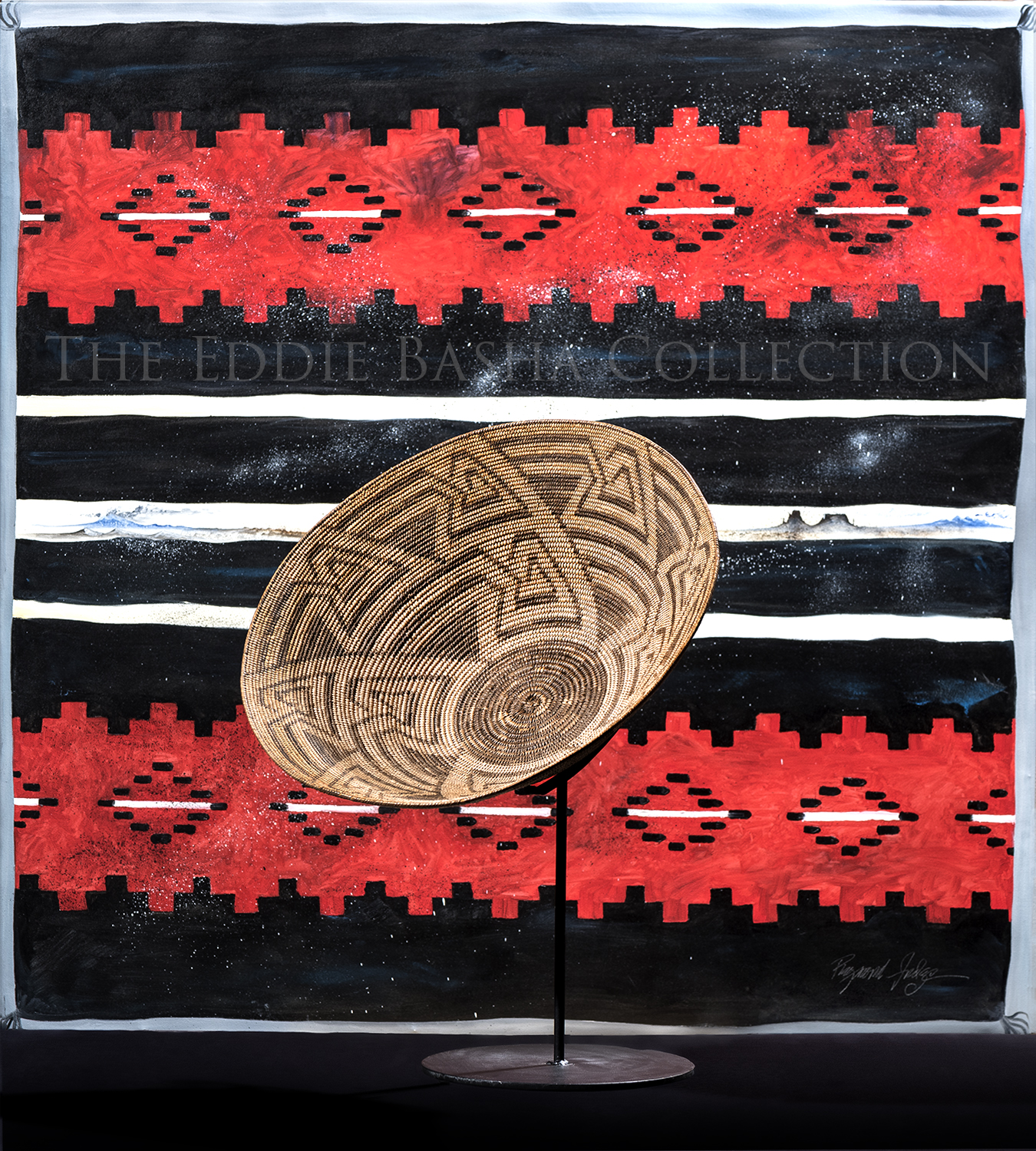
Pima Bowl
Artist: Pima
Description: Willow & Devil’s Claw (Circa 1900) | Dimensions: 18”baskets
This 18” Pima Bowl was woven with willow and devil’s claw over a three-rod foundation. Its unique fretted tarantula motif is highlighted with negative triangles accenting diagonally curved lines gently bending to the left. As its backdrop, featured is a Raymond Judge, Jr. acrylic painting.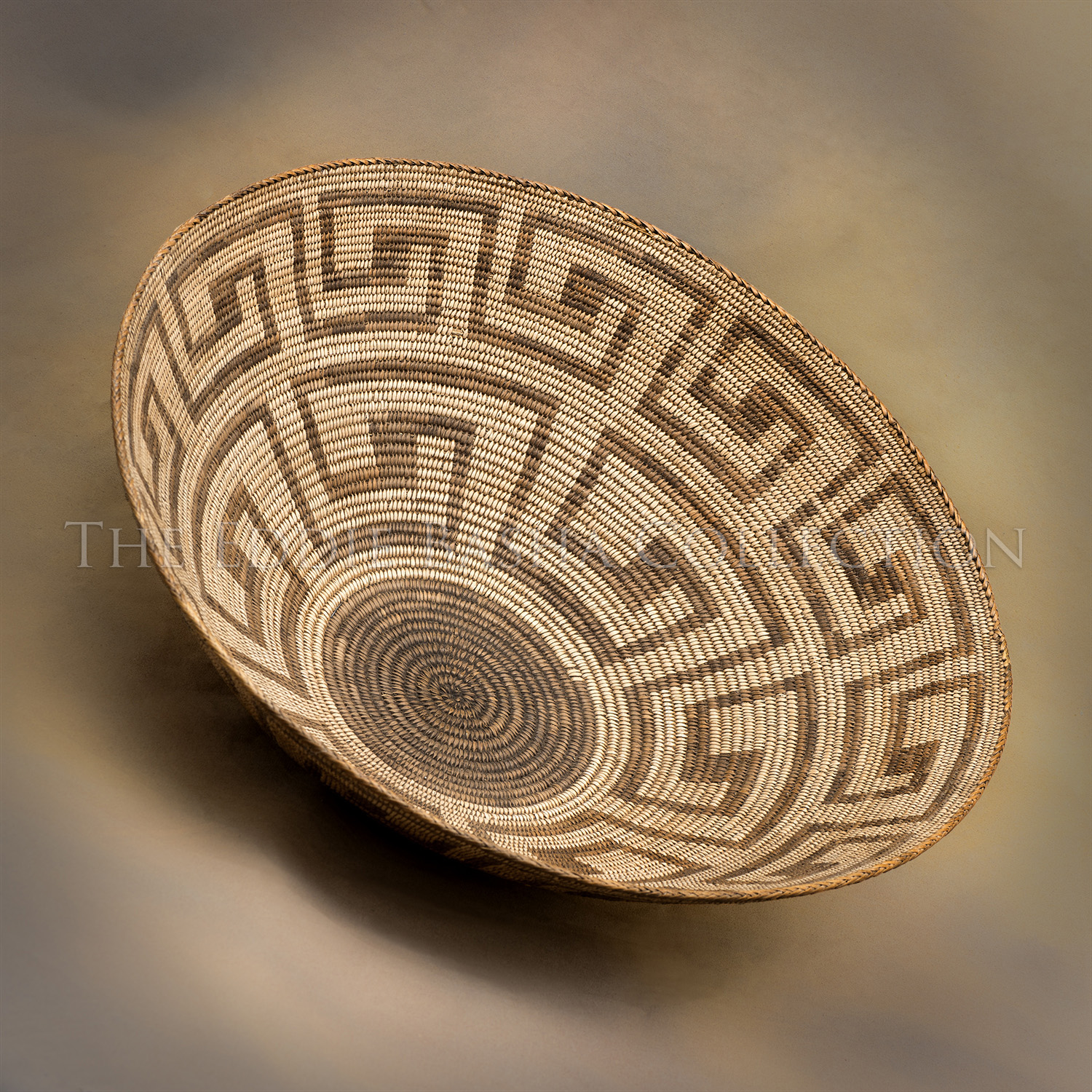
Pima Bowl
Artist: Pima
Description: Willow, devil’s claw, over three-rod foundation (Circa 1900) | Dimensions: 18”baskets
This deep, cactus fruit harvesting bowl with two rows of traditionally-influenced Hohokam fret designs has six frets at the base and eleven at the rim. It was woven with willow and devil’s claw over a three-rod foundation.
Initially baskets were woven for purely utilitarian purposes: Grain was stored inside them, wine was served from them, water was transported in them, games were played on them and stories were woven in them. It is the EBC’s distinct pleasure to preserve this part of Arizona’s rich history and heritage.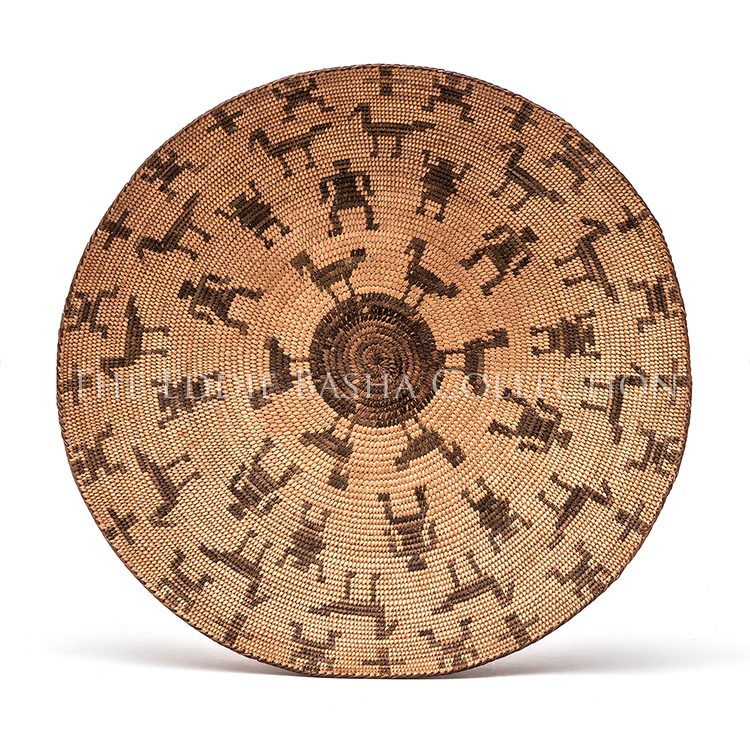
Pima Tray
Artist: Pima
Description: Willow and Devil’s Claw (Circa 1910) | Dimensions: 15 ¾” Diameterbaskets
This 15 ¾” Pima tray, circa 1910, is a finely-woven explosion of human and animal figures throughout with crosses interspersed at the rim. It is woven with willow and devil’s claw over a three-rod foundation.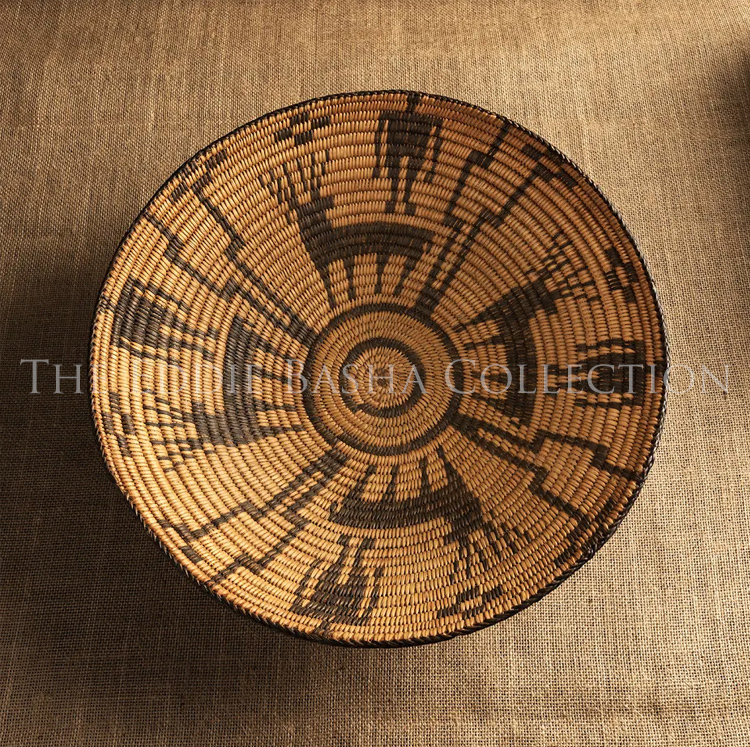
Pima Tray
Artist: Pima
Description: Basket (Circa 1910) | 17 ¼” diameterbaskets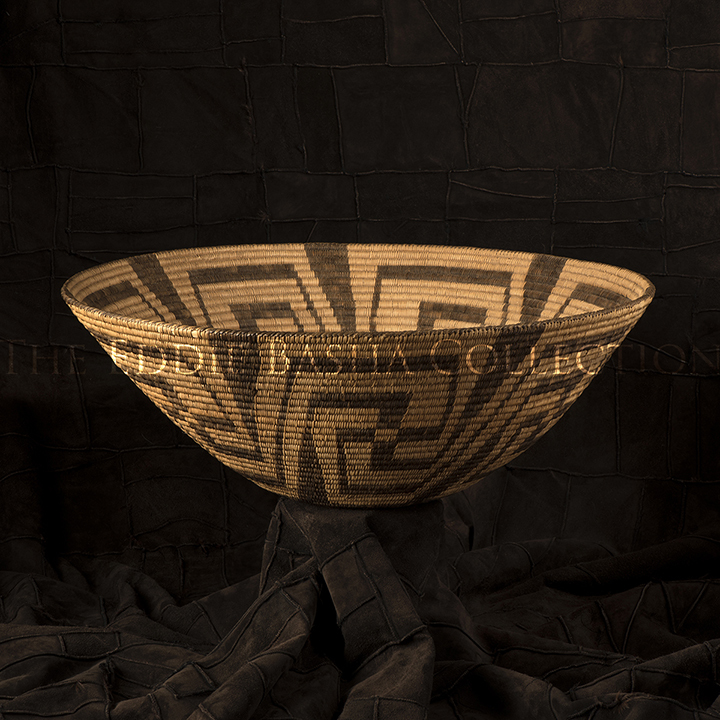
Pima Bowl
Artist: Pima
Description: Willow, devil’s claw over cottonwood (Circa 1890-1900) | 8”h x 23”dbaskets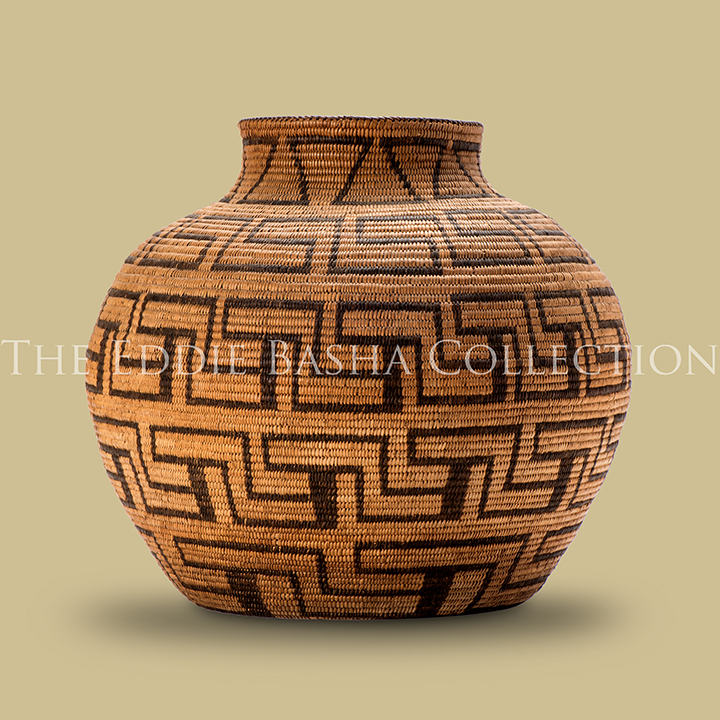
Pima Basket
Artist: Pima
Description: (1900) | 18.5”diameter x 14.5”hbaskets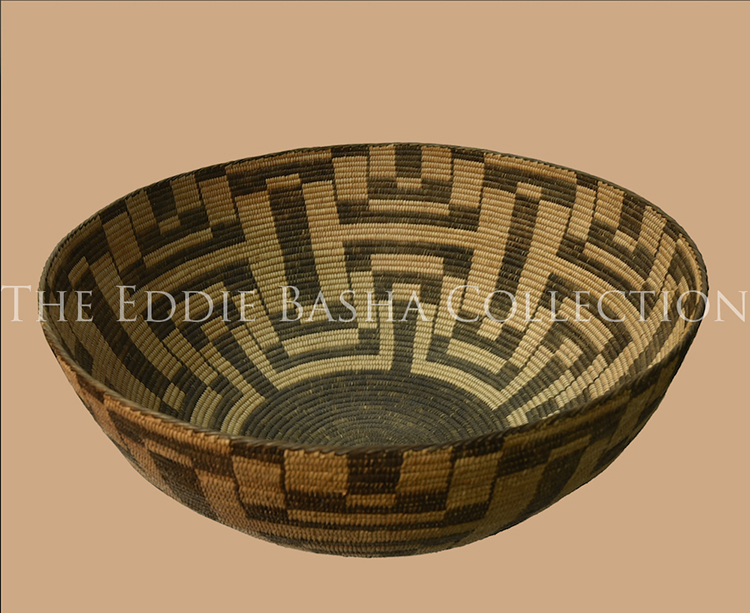
Basket #477 - Pima Wine Basket
Artist: Pima
baskets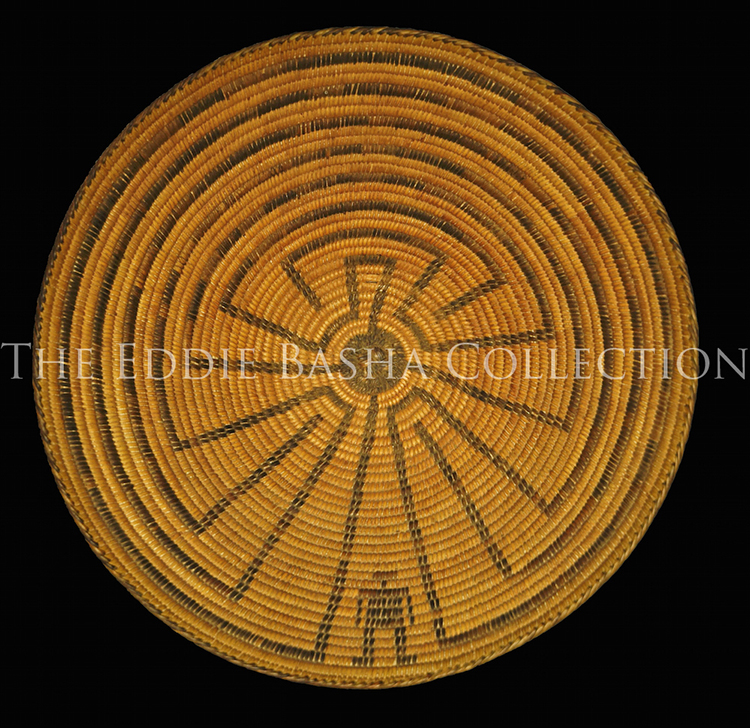
Basket #243 - Man in the Maze 2
Artist: Pima
baskets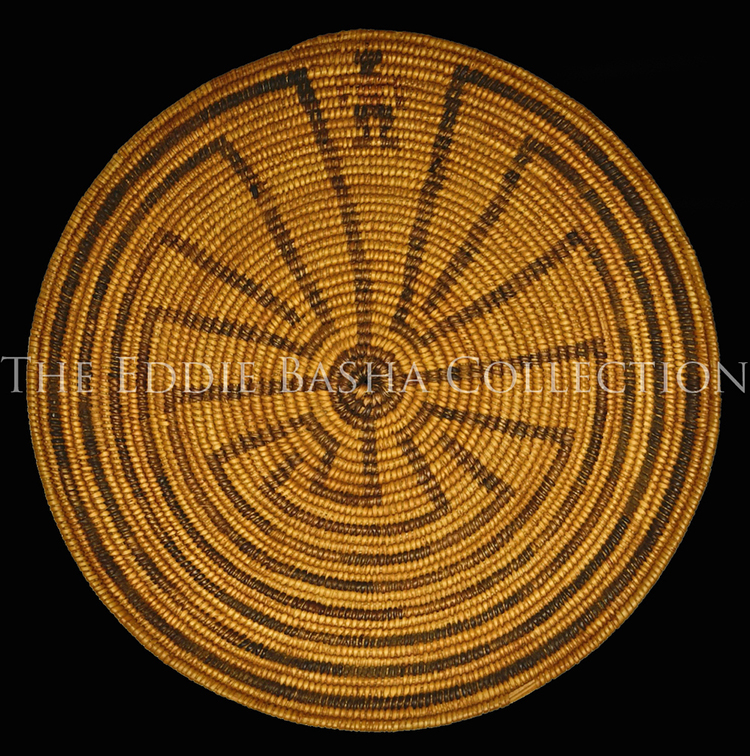
Basket #81 - Man in the Maze 1
Artist: Pima
baskets
Pima Basket
Artist: Pima
Description: (1900) | Classic tarantula design as shown in Robinson’s The Basket Weaver’s of Arizona, Plate V, Page 22, lower right, in a five-petal motif. Willow, devil’s claw, over three-rod foundation.baskets
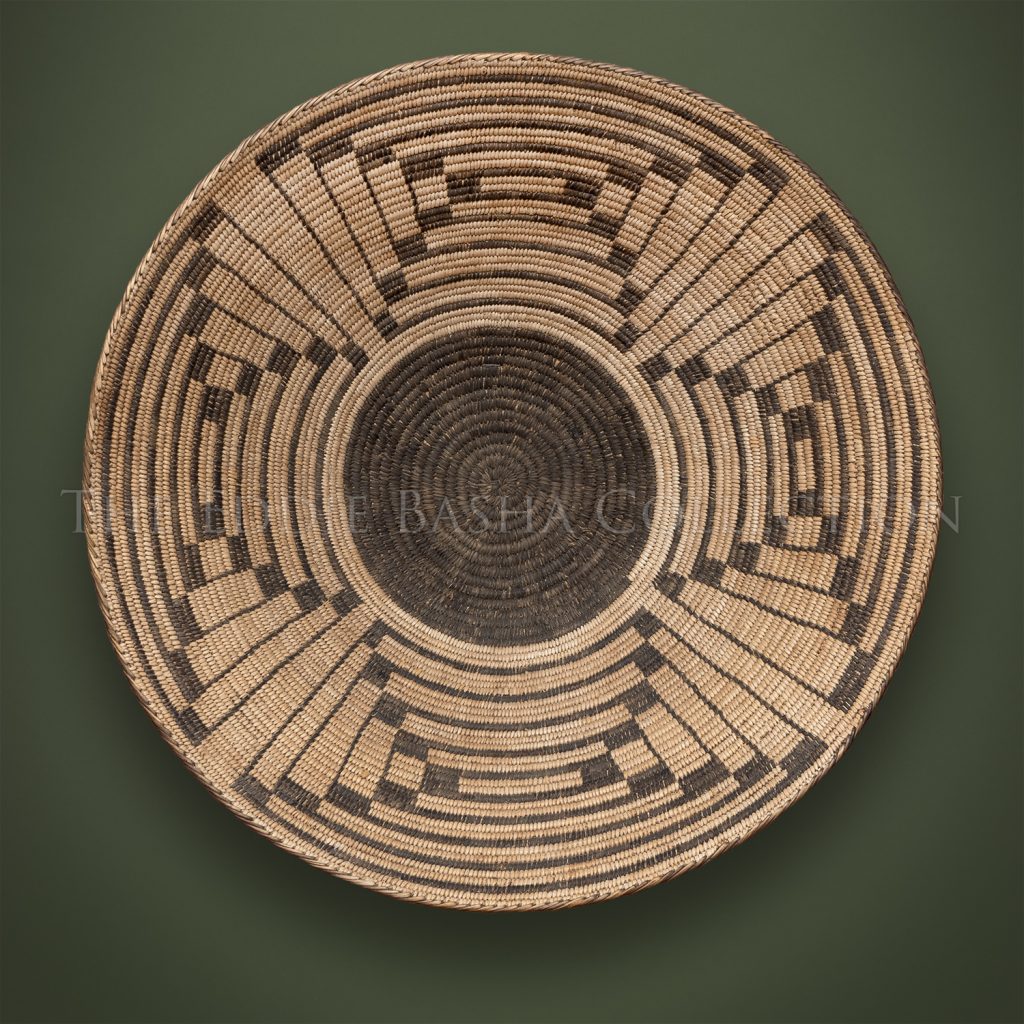 Willow, Devil’s Claw over Three-Rod Foundation (1890) | Dimensions: 20” Diameter
Willow, Devil’s Claw over Three-Rod Foundation (1890) | Dimensions: 20” DiameterThis large Pima tray depicts a classical four-petal turtleback motif with a large black base. The turtleback design was the foundation of the squash blossom pattern. In this basket one may see a four-petal squash blossom pattern within the square turtleback. It was woven with willow and devil’s claw over a three-rod foundation.
Pima Tray
Artist: Pima
Description:
Willow, Devil’s Claw over Three-Rod Foundation (1890) | Dimensions: 20” Diameter
This large Pima tray depicts a classical four-petal turtleback motif with a large black base. The turtleback design was the foundation of the squash blossom pattern. In this basket one may see a four-petal squash blossom pattern within the square turtleback. It was woven with willow and devil’s claw over a three-rod foundation.
basketsThis large Pima tray depicts a classical four-petal turtleback motif with a large black base. The turtleback design was the foundation of the squash blossom pattern. In this basket one may see a four-petal squash blossom pattern within the square turtleback. It was woven with willow and devil’s claw over a three-rod foundation.
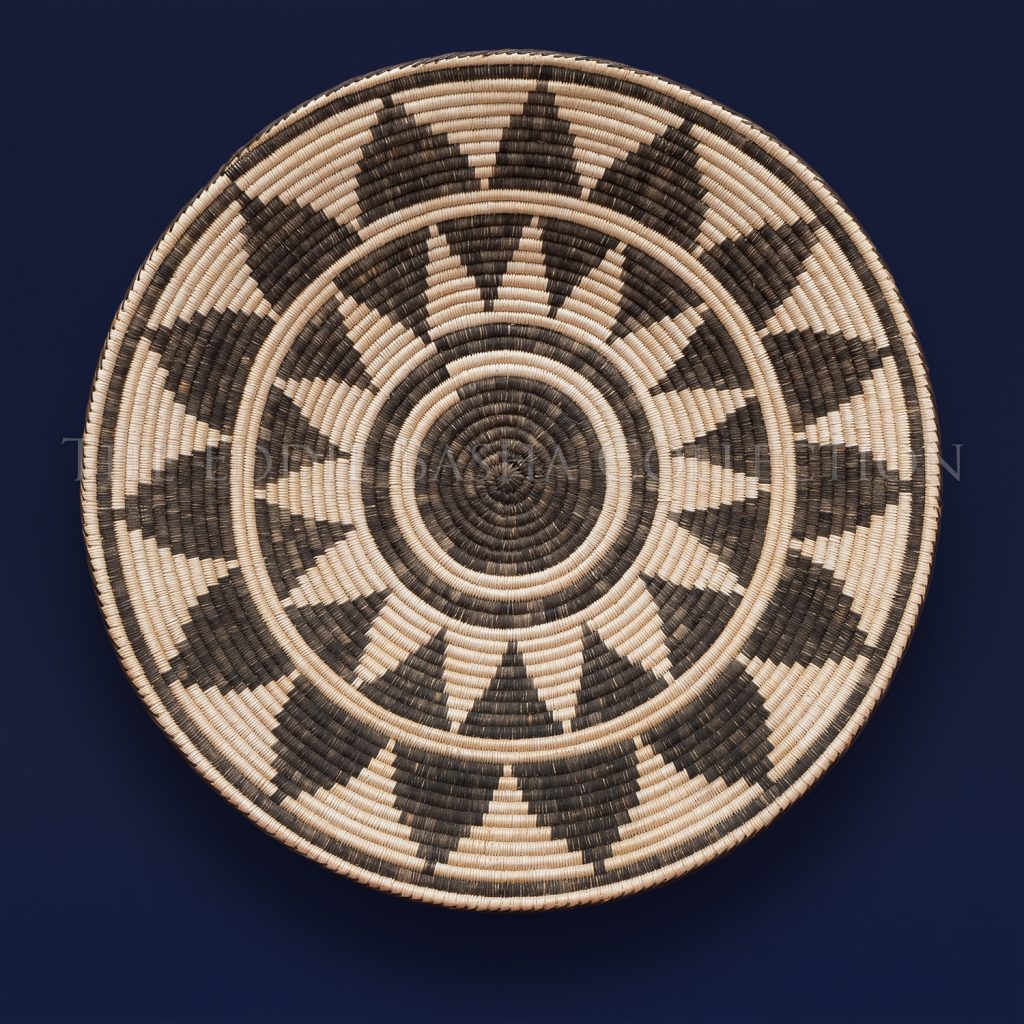 Willow, devil’s claw, over three-rod foundation. (Circa 1950-1970) | Dimensions: 20 ½” Diameter
Willow, devil’s claw, over three-rod foundation. (Circa 1950-1970) | Dimensions: 20 ½” DiameterAn old woven basket pattern described by Breazeale in the book entitled “The Pima and His Basket (1923)” (page 84, figure 74) as the “Pima Sun” design which is a positive/negative radiating sunray motif. This basket motif is also mentioned by Robinson in “The Basket Weavers of Arizona (1954)” as an “old Pima design now seldom used” (page 31, figure plate XVII). This basket is one of the finest examples of a Pima willow basket after World War II and is among one of the last of its kind from the once flourishing abundant array of Pima baskets. It was woven with willow and devil’s claw over a three-rod foundation.
The weaving materials once used are not as readily available as they once were. The Education Department at the Huhugam Heritage Center offers classes and workshops that provide perspectives on aspects of culture, respect and understanding of traditional ecological knowledge system (plants and animals). To revive interest in the basket weaving process and production, the Center implemented one such program wherein participants worked collectively to grow their own materials and study traditional weaving methods of the past. The EBC was honored to host two of these groups that previously visited to study the Pima baskets in the collection.
Pima Tray | Unknown Weaver
Artist: Pima
Description:
Willow, devil’s claw, over three-rod foundation. (Circa 1950-1970) | Dimensions: 20 ½” Diameter
An old woven basket pattern described by Breazeale in the book entitled “The Pima and His Basket (1923)” (page 84, figure 74) as the “Pima Sun” design which is a positive/negative radiating sunray motif. This basket motif is also mentioned by Robinson in “The Basket Weavers of Arizona (1954)” as an “old Pima design now seldom used” (page 31, figure plate XVII). This basket is one of the finest examples of a Pima willow basket after World War II and is among one of the last of its kind from the once flourishing abundant array of Pima baskets. It was woven with willow and devil’s claw over a three-rod foundation.
The weaving materials once used are not as readily available as they once were. The Education Department at the Huhugam Heritage Center offers classes and workshops that provide perspectives on aspects of culture, respect and understanding of traditional ecological knowledge system (plants and animals). To revive interest in the basket weaving process and production, the Center implemented one such program wherein participants worked collectively to grow their own materials and study traditional weaving methods of the past. The EBC was honored to host two of these groups that previously visited to study the Pima baskets in the collection.
basketsAn old woven basket pattern described by Breazeale in the book entitled “The Pima and His Basket (1923)” (page 84, figure 74) as the “Pima Sun” design which is a positive/negative radiating sunray motif. This basket motif is also mentioned by Robinson in “The Basket Weavers of Arizona (1954)” as an “old Pima design now seldom used” (page 31, figure plate XVII). This basket is one of the finest examples of a Pima willow basket after World War II and is among one of the last of its kind from the once flourishing abundant array of Pima baskets. It was woven with willow and devil’s claw over a three-rod foundation.
The weaving materials once used are not as readily available as they once were. The Education Department at the Huhugam Heritage Center offers classes and workshops that provide perspectives on aspects of culture, respect and understanding of traditional ecological knowledge system (plants and animals). To revive interest in the basket weaving process and production, the Center implemented one such program wherein participants worked collectively to grow their own materials and study traditional weaving methods of the past. The EBC was honored to host two of these groups that previously visited to study the Pima baskets in the collection.
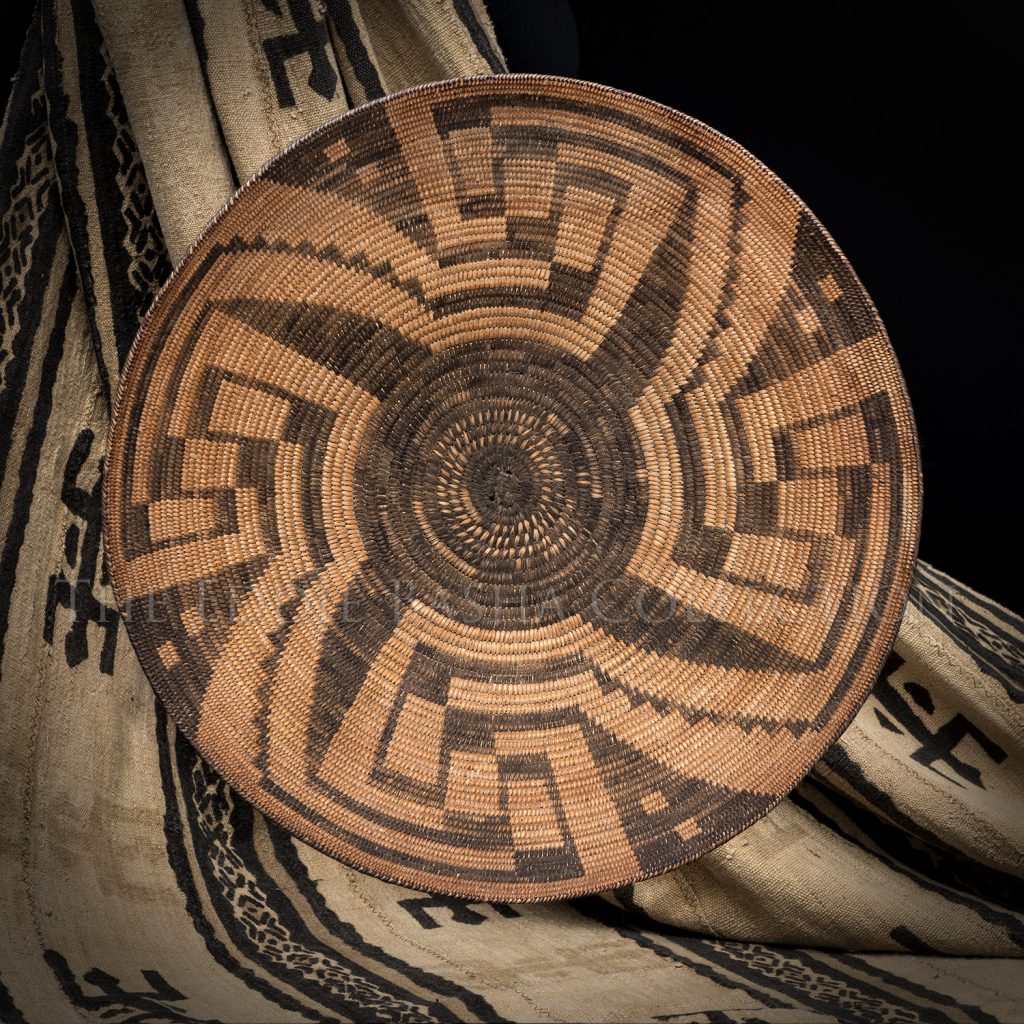 Willow, devil’s claw over cattail (Circa 1900) | Dimensions: 18” Diameter
Willow, devil’s claw over cattail (Circa 1900) | Dimensions: 18” DiameterThis 18” Pima Tray (circa 1900) presents with a balanced fret of whirling logs that have anchor points of diagonally positioned vertical rectangles balanced with negative (dark) triangles containing two small squares in each. It is woven with willow and devil’s claw over cattail.
Pima Tray | Unknown Weaver
Artist: Pima
Description:
Willow, devil’s claw over cattail (Circa 1900) | Dimensions: 18” Diameter
This 18” Pima Tray (circa 1900) presents with a balanced fret of whirling logs that have anchor points of diagonally positioned vertical rectangles balanced with negative (dark) triangles containing two small squares in each. It is woven with willow and devil’s claw over cattail.
basketsThis 18” Pima Tray (circa 1900) presents with a balanced fret of whirling logs that have anchor points of diagonally positioned vertical rectangles balanced with negative (dark) triangles containing two small squares in each. It is woven with willow and devil’s claw over cattail.
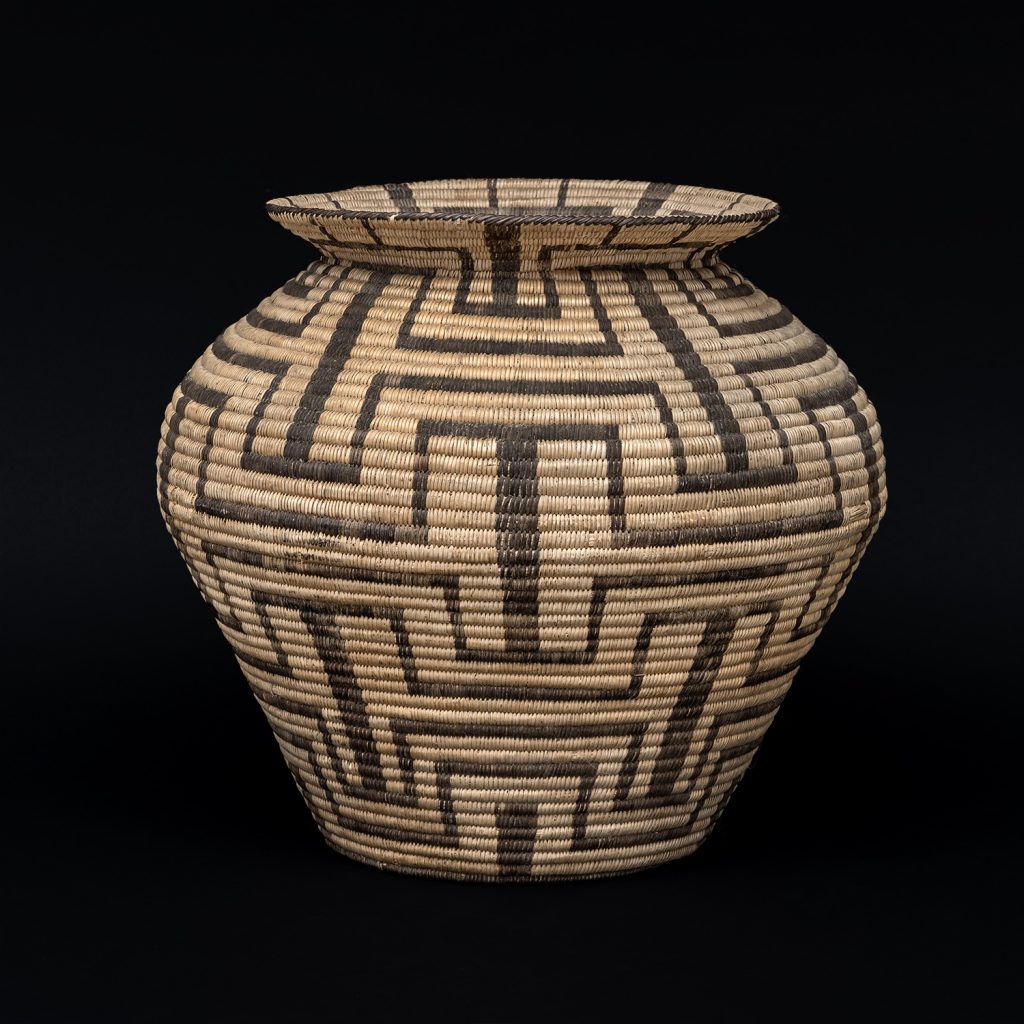 Willow & Devil’s Claw over three-rod foundation (Circa 1920) | Dimensions: 17”h x 14 ½”w
Willow & Devil’s Claw over three-rod foundation (Circa 1920) | Dimensions: 17”h x 14 ½”wThis Pima Olla woven with willow and devil’s claw over a three-rod foundation, circa 1920, presents a bold, terraced field that highlights wide, dark vertical bars. Its unique, elegant flaring mouth is exceptional.
Pima Olla
Artist: Pima
Description:
Willow & Devil’s Claw over three-rod foundation (Circa 1920) | Dimensions: 17”h x 14 ½”w
This Pima Olla woven with willow and devil’s claw over a three-rod foundation, circa 1920, presents a bold, terraced field that highlights wide, dark vertical bars. Its unique, elegant flaring mouth is exceptional.
basketsThis Pima Olla woven with willow and devil’s claw over a three-rod foundation, circa 1920, presents a bold, terraced field that highlights wide, dark vertical bars. Its unique, elegant flaring mouth is exceptional.
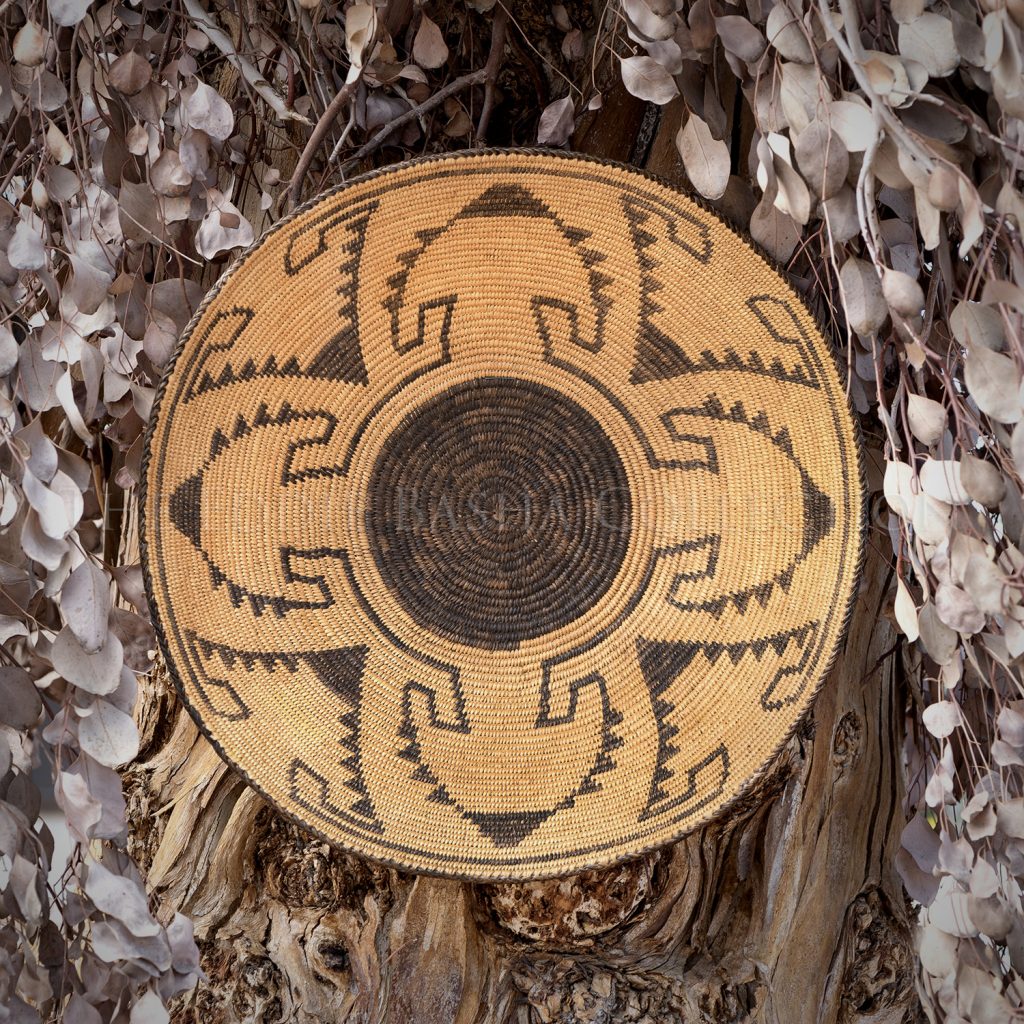 Willow, devil’s claw and cottonwood (Circa 1910) | Diameter: 19 ¼”
Willow, devil’s claw and cottonwood (Circa 1910) | Diameter: 19 ¼”This Pima Tray, 19 ¼” diameter, circa 1910, has four joined serrated arrowhead elements spaced with elaborate serrated “V” designs. It was woven with willow and devil’s claw over cottonwood.
Pima Tray
Artist: Pima
Description:
Willow, devil’s claw and cottonwood (Circa 1910) | Diameter: 19 ¼”
This Pima Tray, 19 ¼” diameter, circa 1910, has four joined serrated arrowhead elements spaced with elaborate serrated “V” designs. It was woven with willow and devil’s claw over cottonwood.
basketsThis Pima Tray, 19 ¼” diameter, circa 1910, has four joined serrated arrowhead elements spaced with elaborate serrated “V” designs. It was woven with willow and devil’s claw over cottonwood.
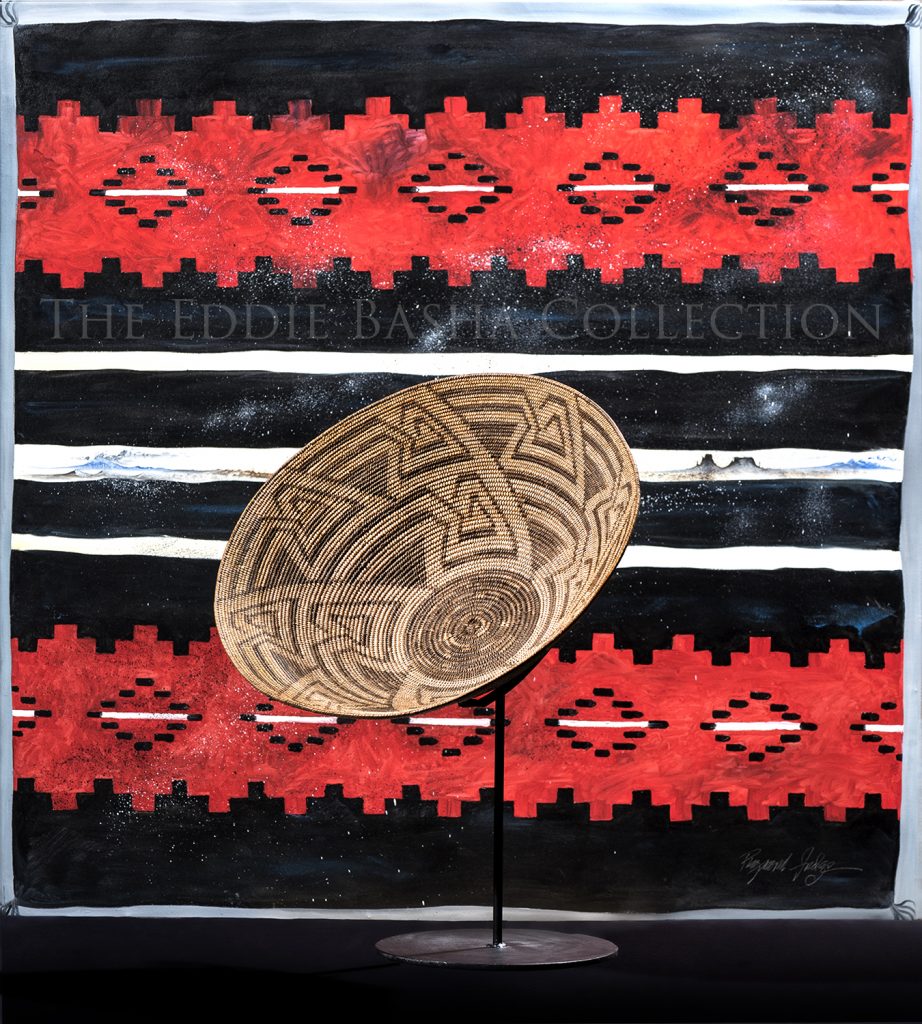 Willow & Devil’s Claw (Circa 1900) | Dimensions: 18”
Willow & Devil’s Claw (Circa 1900) | Dimensions: 18”This 18” Pima Bowl was woven with willow and devil’s claw over a three-rod foundation. Its unique fretted tarantula motif is highlighted with negative triangles accenting diagonally curved lines gently bending to the left. As its backdrop, featured is a Raymond Judge, Jr. acrylic painting.
Pima Bowl
Artist: Pima
Description:
Willow & Devil’s Claw (Circa 1900) | Dimensions: 18”
This 18” Pima Bowl was woven with willow and devil’s claw over a three-rod foundation. Its unique fretted tarantula motif is highlighted with negative triangles accenting diagonally curved lines gently bending to the left. As its backdrop, featured is a Raymond Judge, Jr. acrylic painting.
basketsThis 18” Pima Bowl was woven with willow and devil’s claw over a three-rod foundation. Its unique fretted tarantula motif is highlighted with negative triangles accenting diagonally curved lines gently bending to the left. As its backdrop, featured is a Raymond Judge, Jr. acrylic painting.
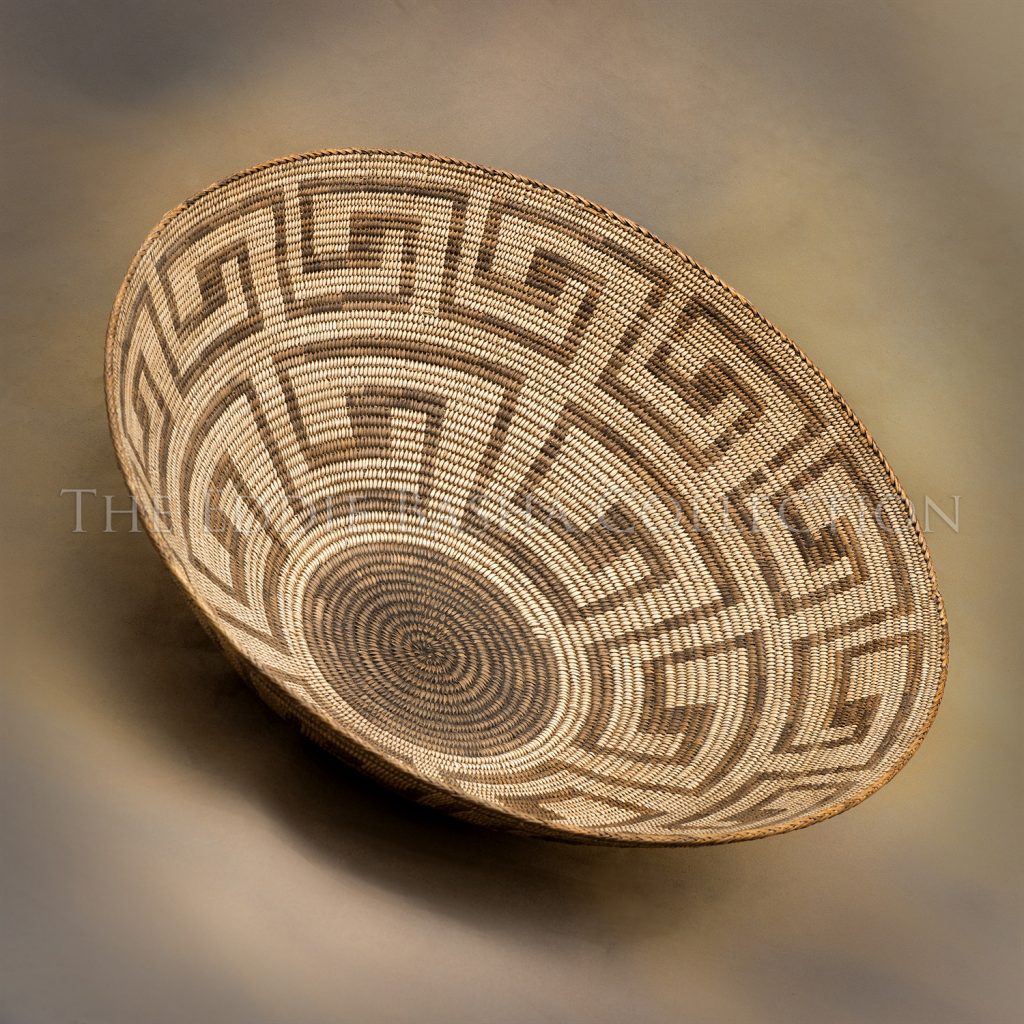 Willow, devil’s claw, over three-rod foundation (Circa 1900) | Dimensions: 18”
Willow, devil’s claw, over three-rod foundation (Circa 1900) | Dimensions: 18”This deep, cactus fruit harvesting bowl with two rows of traditionally-influenced Hohokam fret designs has six frets at the base and eleven at the rim. It was woven with willow and devil’s claw over a three-rod foundation.
Initially baskets were woven for purely utilitarian purposes: Grain was stored inside them, wine was served from them, water was transported in them, games were played on them and stories were woven in them. It is the EBC’s distinct pleasure to preserve this part of Arizona’s rich history and heritage.
Pima Bowl
Artist: Pima
Description:
Willow, devil’s claw, over three-rod foundation (Circa 1900) | Dimensions: 18”
This deep, cactus fruit harvesting bowl with two rows of traditionally-influenced Hohokam fret designs has six frets at the base and eleven at the rim. It was woven with willow and devil’s claw over a three-rod foundation.
Initially baskets were woven for purely utilitarian purposes: Grain was stored inside them, wine was served from them, water was transported in them, games were played on them and stories were woven in them. It is the EBC’s distinct pleasure to preserve this part of Arizona’s rich history and heritage.
basketsThis deep, cactus fruit harvesting bowl with two rows of traditionally-influenced Hohokam fret designs has six frets at the base and eleven at the rim. It was woven with willow and devil’s claw over a three-rod foundation.
Initially baskets were woven for purely utilitarian purposes: Grain was stored inside them, wine was served from them, water was transported in them, games were played on them and stories were woven in them. It is the EBC’s distinct pleasure to preserve this part of Arizona’s rich history and heritage.
 Willow and Devil’s Claw (Circa 1910) | Dimensions: 15 ¾” Diameter
Willow and Devil’s Claw (Circa 1910) | Dimensions: 15 ¾” DiameterThis 15 ¾” Pima tray, circa 1910, is a finely-woven explosion of human and animal figures throughout with crosses interspersed at the rim. It is woven with willow and devil’s claw over a three-rod foundation.
Pima Tray
Artist: Pima
Description:
Willow and Devil’s Claw (Circa 1910) | Dimensions: 15 ¾” Diameter
This 15 ¾” Pima tray, circa 1910, is a finely-woven explosion of human and animal figures throughout with crosses interspersed at the rim. It is woven with willow and devil’s claw over a three-rod foundation.
basketsThis 15 ¾” Pima tray, circa 1910, is a finely-woven explosion of human and animal figures throughout with crosses interspersed at the rim. It is woven with willow and devil’s claw over a three-rod foundation.
 Basket (Circa 1910) | 17 ¼” diameter
Basket (Circa 1910) | 17 ¼” diameterPima Tray
Artist: Pima
Description:
Basket (Circa 1910) | 17 ¼” diameter
baskets Willow, devil’s claw over cottonwood (Circa 1890-1900) | 8”h x 23”d
Willow, devil’s claw over cottonwood (Circa 1890-1900) | 8”h x 23”dPima Bowl
Artist: Pima
Description:
Willow, devil’s claw over cottonwood (Circa 1890-1900) | 8”h x 23”d
baskets (1900) | 18.5”diameter x 14.5”h
(1900) | 18.5”diameter x 14.5”hPima Basket
Artist: Pima
Description:
(1900) | 18.5”diameter x 14.5”h
baskets (1900) | Classic tarantula design as shown in Robinson’s The Basket Weaver’s of Arizona, Plate V, Page 22, lower right, in a five-petal motif. Willow, devil’s claw, over three-rod foundation.
(1900) | Classic tarantula design as shown in Robinson’s The Basket Weaver’s of Arizona, Plate V, Page 22, lower right, in a five-petal motif. Willow, devil’s claw, over three-rod foundation.Pima Basket
Artist: Pima
Description:
(1900) | Classic tarantula design as shown in Robinson’s The Basket Weaver’s of Arizona, Plate V, Page 22, lower right, in a five-petal motif. Willow, devil’s claw, over three-rod foundation.
baskets